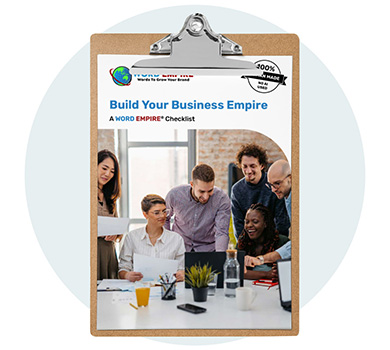7 Types of Content to Grow Your Business in 2024

Content is a major driver of business growth these days. So, you want to be creating it as much as possible. But with so many different types of content out there it can be overwhelming. To help you we’ve compiled this guide that looks at 7 types of content that your customers want and will help drive business growth.
Different Types Of Content For Different Types Of Customers
Different types of content will help you to connect with different types of customers. It’s imperative to understand your audience inside out - both your existing customers and prospects. That way you can create content that is tailored and connects with their needs and wants. The one-size-fits all approach doesn’t work in content creation. Build a winning content strategy to create a great online presence. Hire a content expert to help you. For your strategy to work, ask yourself the following four questions before creating any type of content:
- Who are my customers? (their age, gender, location, demographics, and psychographics)
- What questions do my customers ask? (pain points, frustrations, solutions, etc)
- Where do my customers hang out online? (LinkedIn, Facebook, Twitter etc)
- How do they consume information? (video, text, or combination)
Content Type 1 - A Blog for your Business
Blogs are an important type of content and have been around for a long time. But they have evolved a lot. In the early days of the internet, they were more like personal diary entries of individuals ranting and raving about their lives. There wasn’t much value to the customer. But thankfully they have now become more sophisticated with businesses using them to relate to customers through providing answers and solutions.
You can create a blog on just about any topic and the internet is full of millions of blog posts. They are a great for building trust, authority, and engagement for your brand. They are relatively easy to write but require regular commitment (at least 1-2 times a week). If your time poor just hire a content creator to write your blogs. It’s worth the investment as they are highly shareable and have high potential to go viral. In addition, they favoured by search engines. Keep in mind the following best practices for blogging:
- Impeccable writing (well-written, free of grammar and spelling mistakes)
- Not relying on AI like ChatGPT which Google is starting to penalise
- Use bullet points to break up text
- Break up sections with sub-headings
- Have plenty of white space
- Use high quality images
- Have a compelling headline
- Have a compelling call to action
- Include relevant links
- Use relevant keywords (work them in naturally, no keyword stuffing)
- Only write about topics that interest your target audience
Content Type 2 – Video Creation for Your Business
In 2020 during lockdown video content skyrocketed and was king of the internet with some estimates showing that it accounted for 85% of all web traffic. Fast forward to 2024 and video is still popular. Its easy to see why video is so popular – it offers a more intimate and engaging way to connect with your audience. Consumers in general find videos helpful and are more likely to engage and become a customer with a brand that is creating video content.
Just like with written content there are many types of video you can use to relate to your customers: interviews, expert panel, a behind the scenes look at your brand, vlogs etc. Always create videos that provide value to your audience through answering questions, offering solutions, presenting different perspectives on topics, addressing pain points etc. Never just create a video for the sake of it or because other brands are doing it and so you should too. There must be a purpose behind your video. Keep in mind the following best practices for video:
- Test all equipment and make sure its all in working order
- Focus more on the content than on the technical aspects
- Stick to your time limit as much as possible (try not to go over)
- Include a CTA at the end telling your viewers what to do
- Upload your video to different sites to increase exposure
- Share it on different platforms – website, blog, social media et
- Repurpose it into a blog post, social media post, article etc.
Content Type 3 – Listicles for Your Business
List articles are a highly popular form of content in the digital age with high audience engagement. Consumers relate to them because they are easy to read and remember, scannable and visually appealing. On top of this when done right they are interesting and have high potential to go virally.
They are fairly easy to write given that once you have a topic and a number (eg: 10 Ways to Grow Your Brand in 2024), all that is required is to fill in the blanks. This doesn’t mean though you just throw caution to the wind and not put any thought into your content. Listicles still require high quality and valuable content for audiences. Keep in mind the following best practices for listicles:
- Optimise them for relevant keywords
- Create catchy and unique headings that grab attention
- Ensure the heading matches the content (or else its clickbait)
- Treat them like writing a blog post (sub sections, bullet points, CTAs etc)
Content Type 4- Creating an eBook for Your Business
eBooks are electronic books which are fast becoming a huge content trend. Initially popularised by authors to publish their books, brands are now creating eBooks to create long form content for their customers. Unlike with traditional books, eBooks have a low entry point to publishing and are cheaper to produce and can be sold at wholesale price.
For brands this type of content is a great way for establishing yourself as an expert in your given industry. Customers generally come to see you as an authority in your field after having published an eBook. With eBooks you have great chances of increasing engagement, your expertise, your lead generation and growing your email list. Keep in mind the following best practices for eBooks:
- Be prepared to invest a considerable amount of time on research
- Put effort into the title and the design
- Provide high value by offering solutions
- Spend more time on the content than on promotion and advertising
- Apply the same principles you would to a traditional book
- Break up content using chapters, subheadings, graphics, and other interesting formatting elements
- Use tools like Canva and Designrr to help you create your eBook
Content Type 5- Creating an Infographic For Your Business
Infographics are all about making information visually appealing and are proving to be a popular form of content amongst customers. You can present a huge deal of information like research, statistics, and other data in a way that’s engaging, shareable and digestible. Some research has shown that they are shared on social media three times more than other forms of content. This is good for helping you build backlinks as well as growing your audience. Keep in mind the following best practices for infographics:
- Don’t stuff your infographic with too much information (keep it clean and easy to read)
- Break up content into sections
- Use colour to drive engagement
- Use clear fonts that are easy to read
- Have a descriptive title
- Have a balance of facts and figures (words and figures)
Content Type 6 – Creating Case Studies for Your Business
Case studies demonstrate social proof and help build brand credibility and trust amongst customers. Every brand including startups should include this type of content even if it’s just one case study! Customers place a lot of value on case studies as it gives them hope about your brand. Through case studies you are telling your customers that your brand has helped solve problems and can do the same for them. This is a fast way to build loyalty amongst your customers. Keep in mind the following best practices for case studies:
- Use relatable examples for your customers (use pain points and challenges your customers may have)
- Use the before and after model (present problem and then offer your solution)
- Explain the case using step-by-step examples
- Incorporate strong storytelling (Focus on the how and why of the story)
- Include a strong CTA
Content Type 7 – Creating Long- form Content for your Business
As the name suggests long-form content is longer than your blogs and listicles. It can start at 1,000 words and go up to even 15,000 words. It’s a great way of building thought leadership and expertise. This type of content automatically generates a higher level of respect and trust amongst customers who rely on it for more in-depth knowledge on topics.
Whitepapers and ultimate guides packed with instructions are one of the best forms of long-form content that brands should use to drive growth. Keep in mind the following best practices for long-form content:
- Have clear instructions
- Incorporate checklists and even templates
- Design and layout must be easy to read
- Break tasks up into manageable steps
- Include diagrams, graphics, screenshots etc to highlight crucial points
- Have a mix of facts and figures
- Don’t have too many colours, just stick to 2-3 at the most
These 7 types of content will help drive engagement, conversations and conversions for your business. Take your content strategy to the next level with a winning content plan in place. Our experts will create one for your business. Contact WORD EMPIRE® Today and let’s create something amazing.

